Cosmic Curiosities
“Time is not measured by clocks, but by moments.”
~ Author unknown
Eclipse Reflections
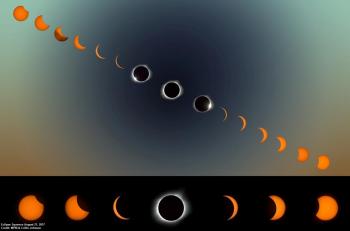 The dimming starts slowly, barely noticeable, around 30 minutes before totality. The false “dusk” slowly grows. The sun is now a crescent and daylight continues to retreat. Glancing around our observation site, things and people look pale in the strange light; shadows are distinctly sharper. Our eyes are drawn upward as a few clouds drift in and cover the Sun. The airy menace obscures our view for nearly 10 minutes… but they move on and blue skies return. The thinning sun escalates, its light now feeble at best. The pace quickens -- or is it our anticipation? The last seconds of sunlight are approaching. To the west, the moon’s shadow is racing toward us. The last drops of sunshine — Baily's Beads. A white flash -- the superb beauty of the Diamond Ring!
The dimming starts slowly, barely noticeable, around 30 minutes before totality. The false “dusk” slowly grows. The sun is now a crescent and daylight continues to retreat. Glancing around our observation site, things and people look pale in the strange light; shadows are distinctly sharper. Our eyes are drawn upward as a few clouds drift in and cover the Sun. The airy menace obscures our view for nearly 10 minutes… but they move on and blue skies return. The thinning sun escalates, its light now feeble at best. The pace quickens -- or is it our anticipation? The last seconds of sunlight are approaching. To the west, the moon’s shadow is racing toward us. The last drops of sunshine — Baily's Beads. A white flash -- the superb beauty of the Diamond Ring!
Suddenly, darkness. The Sun is now black, eclipsed by the Moon. All is upside-down, unexpected. The day has ended with the Sun high in the sky. It’s strange and spectacular, even calming and peaceful, though hearts are racing.
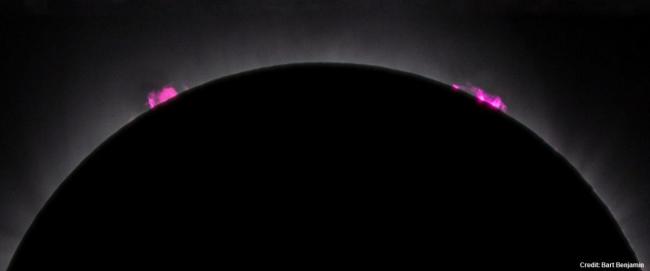
I stare into the Planetarium’s 12-inch telescope -- surreal! The purplish-pink prominences jetting from the sun’s surface are gorgeous. The translucent corona’s -- the sun’s outer atmosphere -- fine white lines stream chaotic but glorious. I am transfixed. I look at the eclipsed sun for what seems like forever; the moment is that strong, the memory burying itself inside me. My mesmerized mind quickly melts away -- I have to share this. I call people over to the telescope, letting them see the power of the eclipse magnified. As I gaze upward and adjust the telescope, I hear our group call out. They gasp and some mutter various OMGs. They cry out with “wow” and “whoa,” or just say, “Unbelievable.” Quiet, reflective sentiments mix with all the excitement.
The second diamond ring means the eclipse is over. The sun is back, its brilliant radiance expanding each second. Many don’t know what to say or do, but words do form and people start to tell their stories. One thing you notice -- they are all smiling.
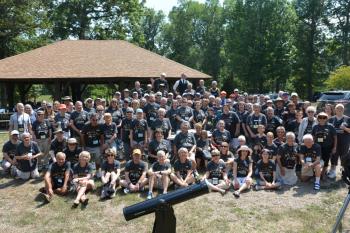 While everyone experiences totality in their own way, the eclipse also unifies. Our group of 110 eclipse chasers from the Milwaukee Public Museum felt many connections. We came from all over -- some from as far away as California, Florida, Pennsylvania, Texas, and New Mexico. One shadow chaser came all the way from England! Our final eclipse viewing spot was Metropolis, Illinois, home of Superman. (The man of steel was properly prepared for the eclipse with giant glasses.)
While everyone experiences totality in their own way, the eclipse also unifies. Our group of 110 eclipse chasers from the Milwaukee Public Museum felt many connections. We came from all over -- some from as far away as California, Florida, Pennsylvania, Texas, and New Mexico. One shadow chaser came all the way from England! Our final eclipse viewing spot was Metropolis, Illinois, home of Superman. (The man of steel was properly prepared for the eclipse with giant glasses.)
Some say this unusual darkness is transformative; I can attest to that feeling. My emotions are very hard to articulate. I only know that I want to see another total solar eclipse of the sun, and I want others to go see it for themselves — maybe even make a connection to the sky and this amazing universe, like the fantastic group of 110 MPM eclipse chasers.
Thanks, everyone, for an amazing adventure!
Eclipse Comparisons
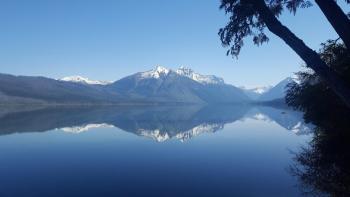 The splendor is unparalleled. Truly, there’s nothing like a total eclipse of the Sun. Comparisons are difficult to find, but let’s try.
The splendor is unparalleled. Truly, there’s nothing like a total eclipse of the Sun. Comparisons are difficult to find, but let’s try.
The spectacular sights in America’s National Parks are majestic and often overpowering. Calling to mind a short list -- Grand Canyon, Great Smoky Mountain, Yosemite, Yellowstone, Rocky Mountain, Glacier, Arches, Zion -- will quickly bring glorious images. These wonders of nature are awe-inspiring. These remarkable vistas are always there, fairly unchanged over a human lifetime. Countless nature lovers get to observe their magnificence -- over 330 million people visited a National Park in 2016.
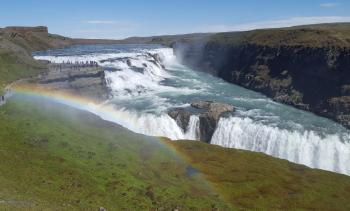 Recently, I was fortunate to visit Iceland. We saw many wondrous waterfalls; gazing upon Gullfoss was one of our favorites. What an exquisite place! The landscape was breathtaking and colorful. Like the National Parks, waterfalls keep going and going. However hypnotic they can be, they don’t stop.
Recently, I was fortunate to visit Iceland. We saw many wondrous waterfalls; gazing upon Gullfoss was one of our favorites. What an exquisite place! The landscape was breathtaking and colorful. Like the National Parks, waterfalls keep going and going. However hypnotic they can be, they don’t stop.
So what sets the total eclipse apart from a majestic mountain or a wondrous waterfall? First, it doesn’t last long. You might think this a disadvantage, yet the brief encounter makes the eclipse so special. Our MPM group experienced only 2 minutes and 23 seconds under the moon’s shadow. Many testified how time flew, making the eclipse seem even shorter. Totality’s terseness makes you think of time and how we spend our moments, like the quote, “Life is not measured by the number of breaths we take, but by the moments that take our breath away.” Well, the eclipse sure does that!
Another distinctive factor of the eclipsed sun is its rarity. The moon’s dark shadow (the umbra) barely reaches the Earth. Though its path stretched from coast to coast across America on August 21, it was only 70 miles wide. The moon’s much lighter shadow (the penumbra) fell upon everyone in America; but partial and total are not the same -- one gets dark, the other doesn’t. If you don’t travel, the chances you have of seeing one are once every 375 years!
Every American -- all 326 million of us -- had a chance to see a partial eclipse, weather permitting. But only 12.2 million people lived in the path of totality. How many traveled to the rare sky event? The estimate is about 2 to 7 million people. This adds up to almost 20 million people experiencing the eclipse at best. That makes it the most-watched solar eclipse in history!
Though the eclipse is still a rare sight for most, it has social media power. A Facebook comparison has the recent eclipse across America outperforming the last four Superbowls. According to Newsweek, “Sixty-six million people created 240 million ‘interactions’ for the eclipse, compared to between 50 million and 65 million people for the football events since 2014.” The article went on to say the eclipse on Twitter was not as strong: “The eclipse garnered less than a quarter of the tweets the most recent Superbowl did.” Maybe that’s because you can’t really describe an eclipse in 140 characters or less -- this story is evidence of that!
The brevity and scarcity of a total solar eclipse are peculiar features. However, when you combine these traits with its exceptional beauty -- you have an experience that is utterly unique. This does not mean it is the best natural wonder one can see; it just makes it different… beyond comparison.
Astronaut Peggy Coming Home
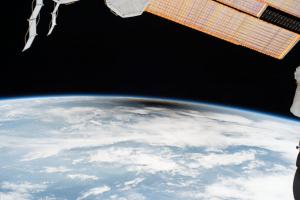 Six people had a very unique view of the eclipse — from space! Instead of looking up at the moon’s shadow, they looked down.
Six people had a very unique view of the eclipse — from space! Instead of looking up at the moon’s shadow, they looked down.
Experiences like this might seem routine to NASA astronaut Peggy Whitson. She has been aboard the space station since last November 2016 without a vacation. But she is finally coming home on September 2. It will have been 289 days since she last walked on planet Earth! It will increase her record total space time for an American to 665 days — almost 2 years of her 21-year career as an astronaut.
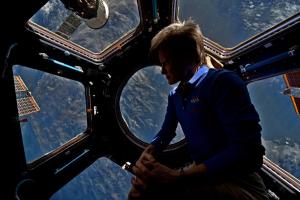 And there’s more to Peggy’s story. She became the first woman to command the space station in 2007. Whitson also holds a record for her 10 space walks, a total of over 60 hours outside the spacecraft. She is also the oldest woman to travel to space at the age of 57. She wanted to be an astronaut in 1983 after she witnessed America’s first woman in space, Sally Ride.
And there’s more to Peggy’s story. She became the first woman to command the space station in 2007. Whitson also holds a record for her 10 space walks, a total of over 60 hours outside the spacecraft. She is also the oldest woman to travel to space at the age of 57. She wanted to be an astronaut in 1983 after she witnessed America’s first woman in space, Sally Ride.
Welcome home, Peggy!
Cassini Dives into Saturn
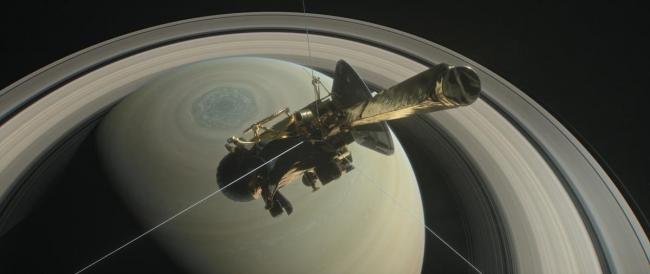
One billion miles from Earth, an epic journey will end on September 15. NASA's Cassini spacecraft will perform a mission-ending dive into the atmosphere of Saturn. Its swan-song plunge will conclude over 13 years of remarkable science of the Saturn system.
Planet researchers still have one more goal before all is said and done. As Cassini barrels into Saturn, it will transmit data that may provide clues to what exactly exists below the cloud tops, and to solve the mystery of whether or not Saturn has a solid core.
Sky Sights
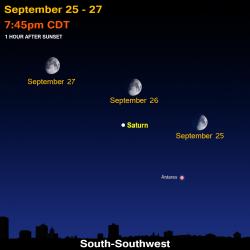
Saturn is still very noticeable low in the south. Look for the Moon to pass by from September 25-27. Though bright, the ringed world will be slightly outshone by the bright stars Arcturus and Vega. Antares, to Saturn’s lower right, is almost as bright. Look for Antares to twinkle more and showcase its vibrant red color.
Jupiter slips away this September. You can see it easily at the start of the month, low in the western sky. By month’s end, it will have moved too close to the Sun’s glare to be easily glimpsed. By early October, the king planet will be gone until it reappears in the morning sky in mid-November.
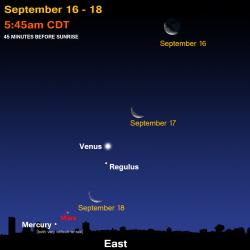
Venus dominates the morning sky. The hottest planet rises two hours before the Sun and stands high in the eastern sky.
Mars and Mercury are visible in the morning sky, but they shine very low and it will take some patience and dedication to spot them; best time is mid-month. The “M & M” planets are very close on September 16 as they pass each other in the sky. Use the Moon to guide you to their locations from September 16-18.
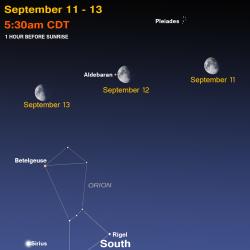
Orion the hunter and the dog star Sirius are much easier to see in the south one hour before sunrise. Look for the Moon to pass very close to the bright star Aldbebaran on the morning of September 12.
Star Map
 Download the September Star Map.
Download the September Star Map.
Sign Up
See the Universe through a telescope! Join one of the Milwaukee-area astronomy clubs and spot craters on the Moon, the rings of Saturn, the moons of Jupiter, and much more.
Send an e-mail to Planetarium Director Bob Bonadurer at bonadurer@mpm.edu and place 'subscribe' in the subject line to receive the Starry Messenger and monthly star map.
![]() Follow Bob on Twitter @MPMPlanetarium.
Follow Bob on Twitter @MPMPlanetarium.

